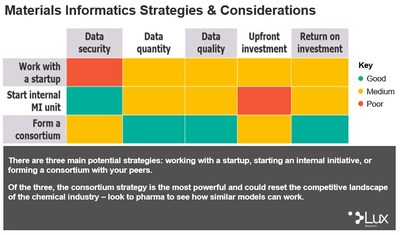Materials Informatics Strategies Will Cut Development Time in Half
Press Releases
Jul 11, 2019
BOSTON, July 11, 2019 /PRNewswire/ — The time is now to form a materials informatics strategy, according to Lux Research, a leading provider of tech-enabled research and advisory services for technology innovation. To navigate innovation in materials informatics, the team at Lux Research developed three strategies for corporate players to engage in the space, outlined in the new report “How to Form a Materials Informatics Strategy.”

“Materials informatics applies data science and artificial intelligence methods to accelerate chemical and material development. Typical applications include property optimization, design of experiments, and product performance optimization. On average, a new material development cycle takes 10 to 20 years. Materials informatics has the potential to shorten the long and costly development cycles for chemicals and materials companies by five to 10 years,” said Xiao Zhong, Ph.D., analyst at Lux Research and lead author of the report.
“Over the past few years, innovation interest in materials informatics has grown exponentially, but materials informatics data challenges require companies to formulate a clear strategy to reap the benefits.” Zhong noted that due to materials informatics’ datacentric nature, early adopters will face a steep learning curve, but these players will also gain a first-mover advantage as they overcome challenges.
The new Lux report reveals three strategies for chemicals and materials companies to penetrate the space. The report also evaluates a company’s potential success by comparing the strategies for varying corporate circumstances. For large companies to successfully reap the benefits of materials informatics, a clear strategy needs to be formed. Although materials informatics provides notable cost savings, it requires large amounts of data to be implemented effectively. Below are the three strategies Lux identified:
1. Working with a Startup:
- Benefits: This is the quickest way to engage in materials informatics, as startups with sophisticated materials informatics platforms can help utilize data to provide value.
- Challenges: Startups themselves usually can’t contribute much data and sharing data with a small startup may not be worth it from the data security perspective.
2. Starting an Internal Initiative:
- Benefits: The result of this strategy will be custom-fit for your needs, and the issues around data sharing and security are eliminated entirely.
- Challenges: This approach requires a company to have both top-notch talent and decades of accumulated data, and this method presents a steep learning curve, as a company’s internal team will have to be tolerant of working by trial and error.
3. Forming a Consortium with Peers:
- Benefits: This strategy allow you to leverage external expertise and data sources to ease development, and this model is likely to accelerate technical advances in the materials informatics landscape.
- Challenges: Complex legal and confidentiality issues around data sharing pose friction to this strategy; it could also pose a risk of lack of differentiation.
“A consortium strategy could reset the competitive landscape of the chemical and material industry, as it is the most powerful of the three proposed materials informatics strategies. As materials informatics’ potential becomes clear, efforts by global governments and industry pioneers have begun to boost development in the space,” Zhong continues.
Lux’s “How to Form a Materials Informatics Strategy” report offers best practices and case studies on the three strategies proposed above. In addition, the report delves deeper into opportunities and challenges for a variety of corporate circumstances.
For more information about how to leverage materials informatics for your organization, download the executive summary.
About Lux Research
Lux Research is a leading provider of tech-enabled research and advisory services, helping clients drive growth through technology innovation. A pioneer in the research industry, Lux uniquely combines technical expertise and business insights with a proprietary intelligence platform, using advanced analytics and data science to surface true leading indicators. With quality data derived from primary research, fact-based analysis, and opinions that challenge traditional thinking, Lux empowers clients to make more informed decisions today to ensure future success.
For more information, visit www.luxresearchinc.com, connect on LinkedIn, or follow @LuxResearch.
Contact Information:
Jess Bonner
press@luxresearchinc.com
(617) 502 -3219

![]() View original content to download multimedia:http://www.prnewswire.com/news-releases/materials-informatics-strategies-will-cut-development-time-in-half-300883117.html
View original content to download multimedia:http://www.prnewswire.com/news-releases/materials-informatics-strategies-will-cut-development-time-in-half-300883117.html
SOURCE Lux Research


